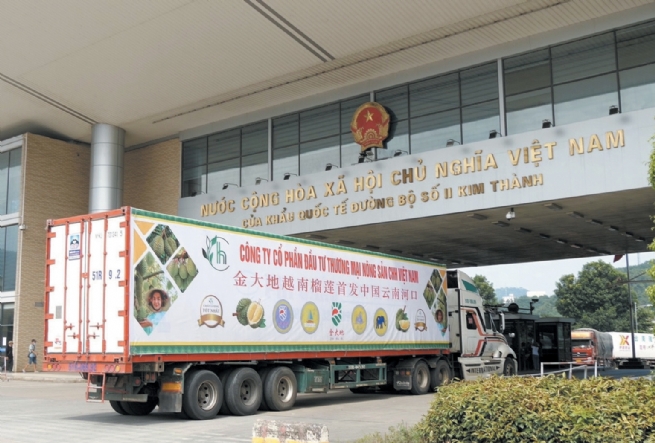8:35:42 AM | 2/27/2025
In 2024, while China's trade with many major partners declined, its trade with Vietnam grew strongly, achieving double-digit growth and emerging as a highlight in bilateral cooperation.

Vietnam’s National Assembly Chairman Tran Thanh Man (R) receives Chinese Ambassador He Wei, January 9, 2025
Strong growth in bilateral trade
According to the General Department of Vietnam Customs, the total bilateral trade turnover between Vietnam and China reached US$205.2 billion in 2024. For many years, China has maintained its role as Vietnam’s key trading partner.
With 1.4 billion people and strong purchasing power, China is an important market for Vietnam. Its geographical proximity reduces transport costs and time, giving Vietnam a competitive edge. Additionally, Vietnamese goods are valued for quality, affordability and high demand, creating strong export opportunities.
On a global scale, Vietnam is currently China’s fourth-largest trading partner and remains its top partner within ASEAN. The two countries have a mutually complementary trade structure. Vietnam exports a variety of key products to China, including agricultural and seafood products, mobile phones and components, computers, electronic products and accessories. Conversely, Vietnam imports essential items from China, such as machinery, equipment, tools, spare parts, textile and footwear materials, and chemicals to support domestic production.
Vietnam's exports to China have grown strongly, while imports from China have also increased significantly. In 2023, Vietnam’s trade deficit with China stood at US$49.35 billion, increasing to US$82.8 billion in 2024.
This trend results from Vietnam exporting mainly low-value agricultural products while importing high-value materials, machinery and equipment from China. Additionally, China has tightened import regulations, shifting to official trade channels to ensure quality and traceability, especially in the agricultural sector.

Efforts are underway to improve border infrastructure and expedite clearance
Policies to boost trade ties
Vietnam and China have adopted policies to facilitate bilateral trade. Both are members of the Regional Comprehensive Economic Partnership (RCEP) and are actively promoting the China-ASEAN Free Trade Area (CAFTA). Additionally, the ongoing upgrade of the ASEAN-China Free Trade Agreement (ACFTA) is expected to further strengthen economic ties.
Vietnam and China have signed a protocol allowing the export of fresh coconuts, frozen durians and farmed crocodiles, contributing to the growth of agricultural exports.
Streamlined customs processes have reduced congestion and logistics costs through close coordination. Trade promotion activities have also been intensified, including events such as the Vietnam Fruit Festival in Beijing and the Asia Food & Beverage Expo 2024. Furthermore, local-level cooperation has expanded, fostering stronger connections with China’s major economic hubs.
Vietnam-China trade relations remain strong, driven by solid cooperation and high-level leadership visits. Notably, during Chinese Premier Li Qiang’s visit to Hanoi in October 2024, he and Vietnamese Prime Minister Pham Minh Chinh signed several key cooperation agreements. Initiatives include boosting agricultural collaboration, enabling cross-border QR code payments, supporting trade transactions, and improving the business environment for both countries.

Vietnam exports various products to China, including fruit and seafood
Enhancing support for exporters
Government ministries, agencies and local authorities are supporting exporters, helping them capitalize on opportunities in China and navigate growing competition.
First, authorities are accelerating the development of modern warehousing facilities to improve quality control and product preservation, and reduce transportation costs. At the same time, efforts are being made to enhance transportation infrastructure connecting border gates, thereby shortening clearance times.
Additionally, governments and relevant organizations are assisting businesses in accessing e-commerce platforms, enabling direct exports without intermediaries. To further enhance efficiency, e-commerce support centers have been established to provide market information and procedural guidance for enterprises.
Government ministries and agencies are also focusing on raising product standards to meet China's import requirements. They are supporting businesses in registering planting area codes and packaging codes, improving traceability and ensuring product quality. Additionally, export procedures are being simplified to help enterprises comply with increasingly stringent standards.
Businesses are also receiving assistance from government agencies and industry associations in directly connecting with supermarkets, wholesale markets and retail channels in China. This support helps reduce intermediary costs and provides guidance on leveraging trade agreements to access preferential tariffs, lower export costs and maximize trade advantages.
By improving infrastructure, strengthening e-commerce, enhancing product quality and establishing direct distribution networks in China, Vietnamese enterprises will be able to expand their market share. Moreover, cooperation in the digital and green economy, and supply chain integration will unlock new opportunities, fostering sustainable growth in bilateral trade.
By Huong Ly, Vietnam Business Forum